|
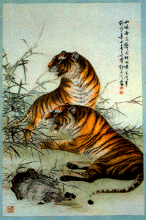 It is one of the most famous Chinese embroideries. It is the general name for the embroidered products around Changsha, Hunan Province. Wu Hanchen, the son of the embroidery craftsman Hu Liangxian, established the first embroidery workshop which sold its self- made embroidered products at the end of the 19th century. It borrowed the merits of Su embroidery and Guang embroidery and combined them with its own folk embroidery. Gradually Xiang embroidery was characterized by the "random needling", which is in contrast with the "even needling. " This needling can highlight the three-dimensional contour of object and produce the effect of halo dyeing. The needling can be subcategorized into indirect, zigzagging, direct and horizontal needlings. The other needling skills include row needling, pattern needling, hole needling and engraving etc. Soaked in the water of pod nuts, the silk thread is smooth and lustrous. The divided silk is as thin as hair. So it enjoys the name of "wool-like embroidery." Then we can find on the embroidered products that the flower could produce perfume, the bird would be heard singing, the tiger could leap forward, and the people seemed to be alive. The embroidered products include Chinese pouch, mirror bag, brush shaft , cushion, pillowship, table cloth, curtain sheath, handkerchief, skirt ornament and belt, etc. It is one of the most famous Chinese embroideries. It is the general name for the embroidered products around Changsha, Hunan Province. Wu Hanchen, the son of the embroidery craftsman Hu Liangxian, established the first embroidery workshop which sold its self- made embroidered products at the end of the 19th century. It borrowed the merits of Su embroidery and Guang embroidery and combined them with its own folk embroidery. Gradually Xiang embroidery was characterized by the "random needling", which is in contrast with the "even needling. " This needling can highlight the three-dimensional contour of object and produce the effect of halo dyeing. The needling can be subcategorized into indirect, zigzagging, direct and horizontal needlings. The other needling skills include row needling, pattern needling, hole needling and engraving etc. Soaked in the water of pod nuts, the silk thread is smooth and lustrous. The divided silk is as thin as hair. So it enjoys the name of "wool-like embroidery." Then we can find on the embroidered products that the flower could produce perfume, the bird would be heard singing, the tiger could leap forward, and the people seemed to be alive. The embroidered products include Chinese pouch, mirror bag, brush shaft , cushion, pillowship, table cloth, curtain sheath, handkerchief, skirt ornament and belt, etc.
 It is one of the most famous Chinese embroideries. It is also called "Cantonese embroidery" and produced in Guangdong Province. It is said that it was created by a minority people. In the middle and at the end of the Ming Dynasty it came into being. Its characteristics include : 1. a variety of threads: silk, down thread, thread twisted from the peacock down or down thread from the horse tail. 2. bright colours in sharp contrast and the lustrous effect. 3. taking gold thread as the contour thread for embroidering the patterns. 4. the male people serving as the embroidering craftsmen. It usually employs the themes of "hundreds of birds paying homage to the phoenix", "marine fish and shrimp", and "melons and fruits." The embroidered products include quilt facing, pillowship, shawl, scarf, clothing and theatrical dress, etc. It is one of the most famous Chinese embroideries. It is also called "Cantonese embroidery" and produced in Guangdong Province. It is said that it was created by a minority people. In the middle and at the end of the Ming Dynasty it came into being. Its characteristics include : 1. a variety of threads: silk, down thread, thread twisted from the peacock down or down thread from the horse tail. 2. bright colours in sharp contrast and the lustrous effect. 3. taking gold thread as the contour thread for embroidering the patterns. 4. the male people serving as the embroidering craftsmen. It usually employs the themes of "hundreds of birds paying homage to the phoenix", "marine fish and shrimp", and "melons and fruits." The embroidered products include quilt facing, pillowship, shawl, scarf, clothing and theatrical dress, etc.
 It is one of the most famous Chinese embroideries. It is also called "Chuan embroidery", for it is mainly produced around Chengdu, Sichuan Province. It is distributed in the countryside nearby Chengdu. Yang Xiong in the Han Dynasty once composed an eulogy of Shu embroidery . The History of Dongyang Kingdom printed in the Dong Jin Period called Shu embroidery and Shu brocade the two treasures of Middle Sichuan. In the Daoguang Period of the Qing Dynasty, many embroidery workshops were set up. The embroidery took locally- produced colourful satin and threads as its materials. The threads are neatly and thickly used, and the colours are elegantly arranged. Its needling characteristics lie in "the even stitches, bright threads, closeness and softness in texture, and both centrifugal and centripetal needling." Its products include mirror curtain, lace, wedding dress, scroll, hats and shoes, skirts, quilt facing, etc. It mainly employs the themes of auspicious happiness. It is one of the most famous Chinese embroideries. It is also called "Chuan embroidery", for it is mainly produced around Chengdu, Sichuan Province. It is distributed in the countryside nearby Chengdu. Yang Xiong in the Han Dynasty once composed an eulogy of Shu embroidery . The History of Dongyang Kingdom printed in the Dong Jin Period called Shu embroidery and Shu brocade the two treasures of Middle Sichuan. In the Daoguang Period of the Qing Dynasty, many embroidery workshops were set up. The embroidery took locally- produced colourful satin and threads as its materials. The threads are neatly and thickly used, and the colours are elegantly arranged. Its needling characteristics lie in "the even stitches, bright threads, closeness and softness in texture, and both centrifugal and centripetal needling." Its products include mirror curtain, lace, wedding dress, scroll, hats and shoes, skirts, quilt facing, etc. It mainly employs the themes of auspicious happiness.
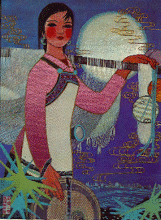 It is a type of modern embroidery. It was invented by the Nantong Institute of Handicraft Arts in Jiangsu Province. It adopts the traditional needlings of folk "colour dotting" and "sewed brocade." The colourful brocade embroidery is characterized by its saving of labour and materials as well as its suitability in decoration. The successful use of this embroidery in the large-scale mural, indoors decorative wall hanging, belt and clothing demonstrates that it is very expressive It is a type of modern embroidery. It was invented by the Nantong Institute of Handicraft Arts in Jiangsu Province. It adopts the traditional needlings of folk "colour dotting" and "sewed brocade." The colourful brocade embroidery is characterized by its saving of labour and materials as well as its suitability in decoration. The successful use of this embroidery in the large-scale mural, indoors decorative wall hanging, belt and clothing demonstrates that it is very expressive
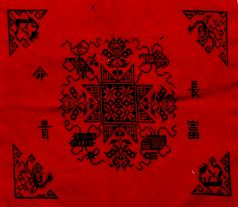 It is also called "patterned weaving" and "cross-shaped embroidery. " It is widely spread among the people. It adopts the cross- shaped stitch to display the patterns and distribute the colours. The threads are arranged horizontally and vertically on the cloth and the patterns are "picked out" by the close cross-shaped needling. The size of the cross-shapes depends on the number of yarns. Generally each cross -shaped needling can have six, five or four yarns. The blue pattern used to be embroidered on the white base. Some minority nationalities embroidered colourful patterns on the blue and black bases, such as the Miao Nationality in Guizhou Province and the Yao Nationality in the west of Hunan Province. It is also called "patterned weaving" and "cross-shaped embroidery. " It is widely spread among the people. It adopts the cross- shaped stitch to display the patterns and distribute the colours. The threads are arranged horizontally and vertically on the cloth and the patterns are "picked out" by the close cross-shaped needling. The size of the cross-shapes depends on the number of yarns. Generally each cross -shaped needling can have six, five or four yarns. The blue pattern used to be embroidered on the white base. Some minority nationalities embroidered colourful patterns on the blue and black bases, such as the Miao Nationality in Guizhou Province and the Yao Nationality in the west of Hunan Province.
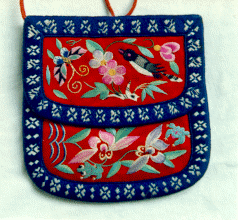 Hebao, the pinyin for Chinese embroidered pouch, is derived from the original name of an ancient food and turns out to be a bag for containing things. There are three shadows of meaning for embroidered pouch: 1. It refers to a bag woven out of satin and cloth. It has a thick inner layer, and is embroidered outside. It is widely spread among people and servers as a gift for expressing friendship and souvenir in social life. It can be used in daily life as mirror bag, fan bag, watch bag, card bag, tobacco bag and wallet, etc. Girls make it for practicing embroidery. There goes a custom in Suzhou of Jiangsu Province that girls begin to learn embroidery and make various pouches at the age of about seven. When married a girl gives the pouches she has made to the relatives and friends of her husband"s family on the occasion of wedding. They act as the gifts and a manifestation of her deftness in handiwork. Secondly, on the Dragon Boat Festival, Chinese people have the custom of inserting Chinese mugwort to exorcise the five poisonous creatures while girls make the embroidered pouches. In the pouch there are mugwort leaves and perfumed grass, so it is also called "perfumed pouch." It is attached to the front of clothing or hung around the child's neck. It can also be hung on the hooks of a bed net. Thirdly, it is a credit symbol for love. It is mainly given by the female part to the male part. 2. It refers to a kind of paper cutting. The paper is cut into pouch shape and can be used as the embroidery base or directly pasted onto the window paper. 3. It refers to a kind of folk song. Especially in the north, this kind of song is narrative and an expression of love. It varies little in music but is abundant in lyrics. In conclusion, the latter two shadows are the derivations of the first. Popularized by the folk song, the unique cultural meanings of the Chinese embroidered pouch is enhanced. Hebao, the pinyin for Chinese embroidered pouch, is derived from the original name of an ancient food and turns out to be a bag for containing things. There are three shadows of meaning for embroidered pouch: 1. It refers to a bag woven out of satin and cloth. It has a thick inner layer, and is embroidered outside. It is widely spread among people and servers as a gift for expressing friendship and souvenir in social life. It can be used in daily life as mirror bag, fan bag, watch bag, card bag, tobacco bag and wallet, etc. Girls make it for practicing embroidery. There goes a custom in Suzhou of Jiangsu Province that girls begin to learn embroidery and make various pouches at the age of about seven. When married a girl gives the pouches she has made to the relatives and friends of her husband"s family on the occasion of wedding. They act as the gifts and a manifestation of her deftness in handiwork. Secondly, on the Dragon Boat Festival, Chinese people have the custom of inserting Chinese mugwort to exorcise the five poisonous creatures while girls make the embroidered pouches. In the pouch there are mugwort leaves and perfumed grass, so it is also called "perfumed pouch." It is attached to the front of clothing or hung around the child's neck. It can also be hung on the hooks of a bed net. Thirdly, it is a credit symbol for love. It is mainly given by the female part to the male part. 2. It refers to a kind of paper cutting. The paper is cut into pouch shape and can be used as the embroidery base or directly pasted onto the window paper. 3. It refers to a kind of folk song. Especially in the north, this kind of song is narrative and an expression of love. It varies little in music but is abundant in lyrics. In conclusion, the latter two shadows are the derivations of the first. Popularized by the folk song, the unique cultural meanings of the Chinese embroidered pouch is enhanced.
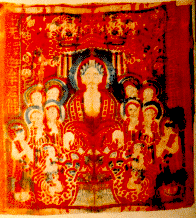 It refers to the dyeing of various fibre textiles, printing skills and printed and dyed textiles. In ancient China people attached manually patterns to the fibre textiles with the natural dyestuffs. This method is handed down until now. In the Han Dynasty there emerged wood-block printing combined with hand dyeing. In the Tang Dynasty the method of printing and dyeing was adopted. Recently this method was adopted in wax dyeing, zha dyeing and tea cloth printing. Some of the colourful printed patterns are made by the direct mould-paper printing or by beating the cloth onto the pattern engraved wood block. In the south of the Changjiang River and Xinjiang they use wood block to print while in the south of Zhejiang Province the pattern- engraved board layers are widely used. It refers to the dyeing of various fibre textiles, printing skills and printed and dyed textiles. In ancient China people attached manually patterns to the fibre textiles with the natural dyestuffs. This method is handed down until now. In the Han Dynasty there emerged wood-block printing combined with hand dyeing. In the Tang Dynasty the method of printing and dyeing was adopted. Recently this method was adopted in wax dyeing, zha dyeing and tea cloth printing. Some of the colourful printed patterns are made by the direct mould-paper printing or by beating the cloth onto the pattern engraved wood block. In the south of the Changjiang River and Xinjiang they use wood block to print while in the south of Zhejiang Province the pattern- engraved board layers are widely used.
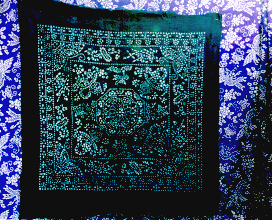 Also called indigo, blue printed cloth is dyed in the indigo. Before overtaken by machine-printed cloth, blue printed cloth was widely used as the staple material for making clothes. The crafts of making blue printed cloth include two types: starching with leaked block and printing with wood block. The blue printed cloth made by the first method used to be called "striped cloth", "flower-watering cloth" or "scraped cloth." This printing method processes like this: they engrave block with oil paper, then scrape the cloth with the mixture of bean powder and lime, and then soak the cloth into the indigo, and at last the mixture is removed. The wood block printed cloth is printed by the directly coloured block. This method used to be widely used in Europe; in China it is used traditionally by the Uygurs. Also called indigo, blue printed cloth is dyed in the indigo. Before overtaken by machine-printed cloth, blue printed cloth was widely used as the staple material for making clothes. The crafts of making blue printed cloth include two types: starching with leaked block and printing with wood block. The blue printed cloth made by the first method used to be called "striped cloth", "flower-watering cloth" or "scraped cloth." This printing method processes like this: they engrave block with oil paper, then scrape the cloth with the mixture of bean powder and lime, and then soak the cloth into the indigo, and at last the mixture is removed. The wood block printed cloth is printed by the directly coloured block. This method used to be widely used in Europe; in China it is used traditionally by the Uygurs.
 It can be found in Guizhou Province and Yunnan Province. It is mainly an ornamental device used by the women of the Miao Nationality for making clothes. The Miao people call batik "wax pattern printing. " A special wax knife is used to dot was on the cloth, and is handed down form generation to generation. There have appeared some patterns such as spiral pattern. It can be found in Guizhou Province and Yunnan Province. It is mainly an ornamental device used by the women of the Miao Nationality for making clothes. The Miao people call batik "wax pattern printing. " A special wax knife is used to dot was on the cloth, and is handed down form generation to generation. There have appeared some patterns such as spiral pattern.
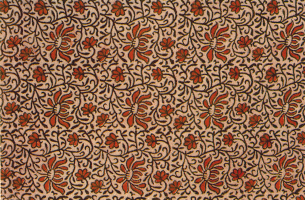 It is a blue printed cloth made by the Uygurian people in Xinjiang. It is printed by the relief wood block, mainly in geometrical patterns . It has some other patterns such as flowers and grasses. It is a blue printed cloth made by the Uygurian people in Xinjiang. It is printed by the relief wood block, mainly in geometrical patterns . It has some other patterns such as flowers and grasses.
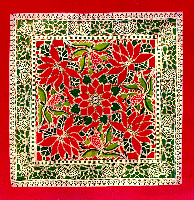 It is a type of printed cloth on which the patterns are printed in colours besides blue. It is generally called "patterned cloth-wrapper. " There are two printing technologies for it: "pattern printing with leaking block" and "pattern printing with wood block." It is a type of printed cloth on which the patterns are printed in colours besides blue. It is generally called "patterned cloth-wrapper. " There are two printing technologies for it: "pattern printing with leaking block" and "pattern printing with wood block."
|
 |
重点阅读
[错误报告] [推荐] [收藏] [打印] [关闭] [返回顶部]

 已有
已有













